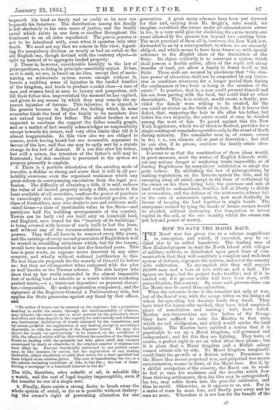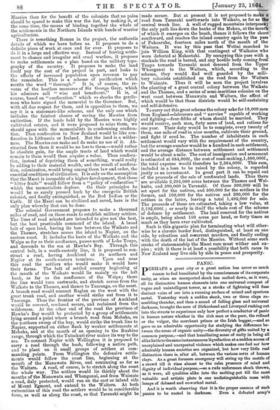HOW TO SAVE THE MAORI RACE.
THE Maori war has given rise to a scheme magnificent in conception, and which, if executed, may be en- titled also to be called beneficent. The leading men of New Zealand propose to stud the North Island with villages of military settlers, so distributed upon great lines of com- munication that they will constitute a complete and well-knit system of defence, segregate the natives, and cover the country with cultivation. To accomplish this they will require 20,000 men and a loan of two millions and a half. The figures are large, but the project looks feasible ; and if it be carried out, few greater works will have been done, with premeditation, this century. By some such process-alone can the Maori race be saved from extinction.
What the colonists desire is the cessation not only of war, but of the fear of war, with the savage tribes on the fringes of whose far-spreading but desolate lauds they dwell. They have tried the laissez-alter method, they have tried empirical plans of conciliation and nursing ; both have failed. Neither non-intervention nor the bribes of Sir George Grey have sufficed to raise the Maories to that state which we call civilization, and which would render the land habitable. The Maories have imbibed a notion that it is practicable to set up a Maori kingdom, self-governed and independent; and for this they are fighting. They have, of course, a perfect right to act on what ideas they please ; but it is plain that a Maori kingdom and a British colony cannot subsist side by side. No Maori -kingdom imaginable could limit the growth of a British colony. Persistence in the Maori idea means perpetual war, and perpetual war means extermination, sooner or later, of the Maori race. But if by a skilful occupation of the country, the Maori can be made to feel at once his weakness and the benefits which flow from thriving settlements, then his idea may be extinguished; he, too, may settle down into the peaceful cultivator, and thus he saved. Otherwise, as it appears to us, not. For in a series of wars he must lose, and finally pass away and be seen no more. Wherefore it is not less for the benefit of the Maories than for the benefit of the colonists that no pains should be spared to make this war the last, by making it, at the same time, the means of binding together the whole of the settlements in the Northern Islands with bands of warrior agriculturists.
There is something Roman in the project, the authentic details of which we have before us. It proposes to do a definite piece of work at once and for ever. It proposes to do it in a large and effective way. Instead of leaving settle- ment to chance and irregular and cruel warfare, it proposes to make settlements on a plan based on the military topo- graphy of the country. It proposes to make the land itself pay the cost of the project in part, and looks to the effects of increased population upon revenue to pay the remainder. This is a scheme of pacification which merits the word " thorough." It is, of course, the re- verse of the bootless measures of Sir George Grey, which his admirers call " wise and beneficent." It is, of course, based on "confiscation," which so shocks the gentle- men who have signed the memorial to the Governor. But, with all due respect for them, and in opposition to them, we say it is a statesman-like scheme, and the only one which includes the faintest chance of saving the Maories from extinction. If the lands held by the 31aories were highly cultivated estates, and it were proposed to seize them, we should agree with the memorialists in condemning confisca- tion. Then confiscation in New Zealand would be like con- fiscation in Lithuania or Ireland. But the land is a wilder- ness. The Maories can make and do make no use of it. Ab- stracted from them it would be no loss to them—would rather be absolute gain, for the ample tracts of land which would remain to them would then acquire a value. Thus confisca- tion, instead of depriving them of something, would really be adding to their material wealth, and the result of confisca- tion, colonization, would bring among them law and order, the essential conditions of civilization. It is only on the assumption that the Maori is incapable of a higher development, that those " bitter fruits " would follow from a " policy of confiscation " which the memorialists deplore. On their principles he would be as surely pressed back by the energetic British colonist, and finally extinguished, as the Red Indian or the Carib. If the Maori can be civilized and saved, here is the only plan whereby that can be done.
The colonial Government proposes to make a thousand miles of road, and on these roads to establish military settlers. The lines of road selected Are intended to give not the best, but the best practicable command of the island. A broad belt of open land, having its base between the Waikato and the Thames, stretches across the island to Napier, on the eastern coast. It includes the basin of the Waikato and the Waipa as far as their confluence, passes north of Lake Taupo, and descends to the sea at Hawke's Bay. Through this central belt, in a south-easterly line, it is proposed to con- struct a road, having Auckland at its northern and Napier at its south-eastern terminus. Upon and near this road the settlers who would make it would have their farms. The belt of settled country beginning at the mouth of the Waikato would lie mainly on the left bank, as far as the confluence of the Waipa; there the line would turn eastwards, and stretch across from the Waikato to the Thames, and thence to Tuaranga, on the coast. A branch road would connect Raglan on the west with the great trunk road, and another would strike out from it to Tnaranga. Thus the frontier of the province of Auckland would be covered, rendered secure, and reclaimed from the wilderness. At the other end of the road the province of Hawke's Bay would be protected by a group of settlements lying around a point where a branch road from Mohaka, on the northern sweep of the bay, would strike the trunk line to Napier, supported on either flank by weaker settlements at Mohaka, and at the mouth of an opening in the Ruahine range, through which the Tutaekuri river makes its way to the sea. To connect Napier with Wellington it is proposed to carry a road through the bush, following a native path, and to plant on it small groups of settlers at com- manding points. From Wellington the defensive settle- ments would follow the coast line, beginning at the mouth of the Manawatu River, and continuing as far as the Waitara. A road, of course, is to stretch along the coast the whole way. The settlers would lie thickly about the mouths of the Manawatu and Whanganui, and from Waimate a road, duly protected, would run on the east or inland side of Mount Egmont, and extend to the Waitara. At both extremities of this road the settlers would be in considerable force, as well as along the coast, so that Taranaki might be made secure. But at present it is not proposed to make a road from Taranaki northwards into Waikato, as far as the central trunk line. A wall of rugged mountains interposes ; the only path lies down the banks of the Mokau, at the mouth of which it emerges on the beach, thence it follows the shore southward, and reaches the inland country again by the pass of Pukearuhe, fourteen miles north of the mouth of the Waitara. It was by this pass that Wetini marched to join William King, with that contingent of Waikatos who were defeated at Mahoetahi. By occupying this pass with a stockade the road is barred, and any hostile body comi g front' Taupo towards Taranaki must descend from the Upper Whanganui to the Waitara, which, according to the scheme, they would find well guarded by the mili- tary colonists established on the road from the Waitara to Waimate. Thus it will be seen the project involves the planting of a great central colony between the Waikato and the Thames, and a series of semi-maritime colonies on the west coast between Manawatu and Waitara, the effect of which would be that these districts would be self-sustaining and self-defensive.
To carry out this great scheme the colony asks for 18,000 men from England—labourers and " navvies " capable of working and fighting—four-fifths of whom should be married. They would receive, each man, forty acres of land, and rations for one year. Their duty would be to complete, every twenty of them, one mile of road in nine months, cultivate their ground, and fight if need be. The number of inhabitants in each settlement would vary with the requirement of the country, but the average number would be a hundred in each settlement, and the average distance between settlement and settlement would be about a mile. The cost of immigration and armament is estimated at 684,0001., the cost of road-making,1,500,000/., the total expense would therefore be 2,384,0001. This sum, included in a loan to be raised by the colony, is regarded justly as an investment. In great part it can be repaid out of the proceeds of the sale of confiscated lands. Thus there are available 2,292,000 acres between the Thames and Wai- kaito, and 500,000 in Taranaki. Of these 500,000 will be set apart for the natives, and 500,000 for the settlers in the former, and 100,000 for the natives and 200,000 for the settlers in the latter, leaving a total 1,492,000 for sale. The proceeds of these are estimated, taking a low value, at 2,192,0001.; or nearly in itself the whole cost of the scheme of defence by settlement. The land reserved for the natives is ample, being about 150 acres per head, or forty times as much as they have ever cultivated. Such is this gigantic plan for terminating what will other- wise be a chronic border feud, distinguished, at least on one side, by relentless and recurrent murders, and finally ending with the death of the last of the Maories. Without some such stroke of statesmanship the Maori race must wither and ex- pire ; with it there is at least a possibility that both races in New Zealand may live side by side in peace and prosperity.



































 Previous page
Previous page